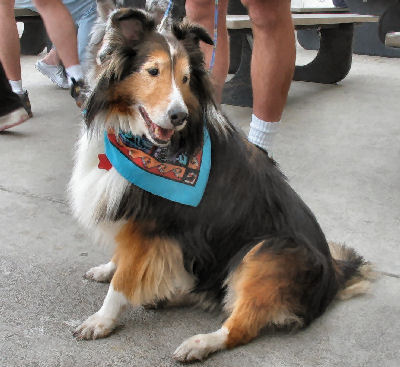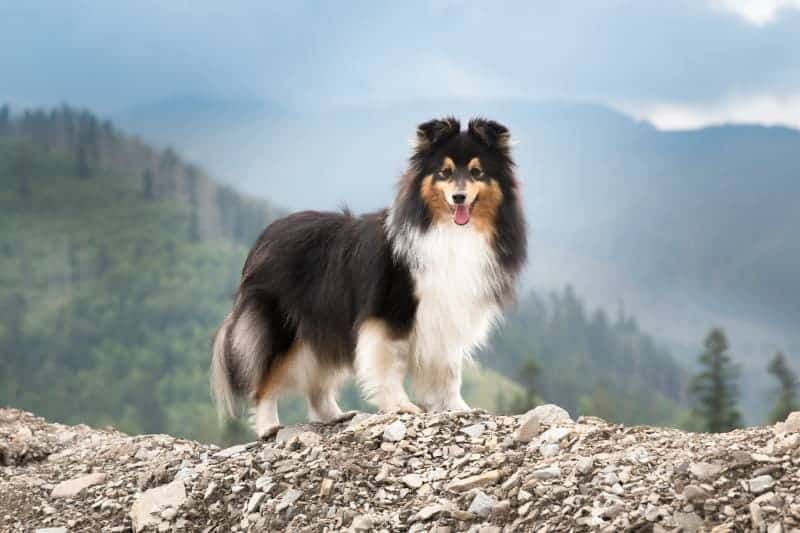
The Shetland Sheepdog or the Sheltie, has all of the desirable qualities of the Rough Collie, but in a smaller package.
Like the Collie, the Sheltie has an absolutely beautiful appearance to go along with its loyal, affectionate, and obedient nature. Additionally, the Sheltie demands less activity than the Collie, which makes it a suitable pet for smaller living environments. The Sheltie is an excellent pet for families and individuals.
- Kingdom: Animalia
- Phylum: Chordata
- Class: Mammalia
- Order: Carnivora
- Family: Canidae
- Genus: Canis
- Species: lupus familiaris
Common Name(s)
Shetland Sheepdog, Sheltie, Dwarf Scotch Shepherd
Breed Type
This breed is a member of the herding dogs. These dogs were bred for herding cattle or sheep, which explains many of their characteristics. They are extremely active, intelligent, and driven to work. If not provided with an organized activity, such as herding trials or Flyball, these dogs are likely to find something less desirable to do, such as digging up gardens or chewing on shoes. Herding dogs are still currently used to herd livestock, but they can also be great pets for active owners with the time and energy to meet their needs.
Background
The Shetland Sheepdog is a miniature version of the Rough Collie. It is widely believed that the Shetland Sheepdog and current show Collie came from the same small working Collie ancestor, with the Shetland Sheepdog evolving from the smaller lines and the Rough Collie evolving from the larger lines.
The Shetland Sheepdog originates from the Shetland Islands, which is known for producing diminutive ponies and cattle, as well as Collies. The islands are of a rugged nature, full of rocks, and experiencing frequent storms, which is conducive to creating hardy, miniature animals. The exact year of origin is unknown for this breed, but tradition holds that they are as old as the Shetland Islands. These dogs were first recognized as Shetland Collies by the Kennel Club (England) in 1909. Later, in 1914, they were classified separately as Shetland Sheepdogs. The American Kennel Club registered the first Shetland Sheepdog, Lord Scott, in 1911. Currently, this breed is popular in Japan, Great Britain, and North America.
Description
The Shetland Sheepdog is a moderately small breed, weighing in at 14-30 pounds and standing 13-16 inches at shoulder height. The American standard states that Shetland Sheepdogs must be between 13 and 16 inches in height in order to qualify at shows, but taller and shorter Shelties exist. Like the Collie, the Sheltie’s head is long, thin, and tapering. The eyes are dark and almond-shaped, and the ears are small and semi-erect. The neck is muscular and the tail is medium-length
Like the Rough Collie, the Shetland Sheepdog has a long straight double coat on most of the body, a luxurious mane, and short smooth hair on the face, tips of ears, and feet. Coat colors include black, blue merle, and sable with varying amounts of white and/or tan.
Care and Feeding
Shelties have no special dietary needs, though they do have rather demanding grooming requirements. Due to their long, dense double-coat, they must be groomed 2 or 3 times a week for about 20 minutes each.
Shelties need regular checkups. Vaccinations are due as follows:
- 6-8 weeks: Distemper, Leptospirosis, Hepatitis, Parainfluenza, Parvo, and Corona virus (DHLPPC)
- 10-12 weeks: Second DHLPPC
- 14-16 weeks: Third DHLPPC and rabies
- Annually: DHLPPC and rabies booster
Housing Your Dog
Unlike the Collie, the Sheltie can be content in an apartment, as long as it is brought outside regularly for exercise. The Sheltie, of course, can also live in rural areas where there is room to roam.
Social Behaviors
The Shetland Sheepdog is a friendly breed. Though it may be initially shy around strangers, it generally is not fearful of them. Like other herding breeds, the Sheltie has a tendency to herd other animals and small children.
Handling and Training
Like most dogs, the Sheltie benefits from obedience training. In fact this breed is often the star at obedience trials.
Activities
Shelties are active dogs that enjoy a large amount of exercise. However, they do not need as much structured activity time as the Collie, and can be content as a more sedentary companion.
Breeding/Reproduction
Average litter size is 4-6 pups.
Common Health Problems
Shelties, like Collies, are at risk for eye diseases, including Progressive Retinal Atrophy and Collie Eye Anomaly (CEA). Progressive retinal atrophy causes night blindness first, and then day blindness. There is no treatment for this disease, but many dogs adapt well to blindness, with few signs of the ailment, as long as they are in a familiar setting.
Collie eye anomaly (CEA), also known as scleral ectasia syndrome or collie ectasia syndrome, is an inherited disorder in which the eye tissue is not properly formed in the fetus. Though it was originally found in the Collie, it can also be present in Australian Sheepdogs, Border Collies, and Shetland Sheepdogs. The anomaly can cause a variety of eye defects, including detached retinas, optic nerve anomalies, and a loss of retinal cells. The vision impairment that this disorder causes can be mild to severe. Currently, there is no treatment for CEA.
Prevention consists of selecting dogs without the anomaly for breeding. Additionally, miniaturization has increased the risk of leg fractures in this breed.
Availability
The Sheltie is a popular breed and is readily available from breeders on the internet and locally. Due to its popularity, prospective owners should be careful to only buy from reputable breeders that are careful in breeding dogs with positive qualities. Prices range greatly, depending on whether its a puppy or an adult, and whether you are looking for pet quality, or show and breeding quality. One reader recently said you may find an adult for as little as $300 (more at a reputable breeder), but expect to pay $800-$1200 for pet quality puppies, and $2000-$3500 for show and breeding quality puppies.
References
Dog Breed Info Center (2008), http://www.dogbreedinfo.com/collie.htm
Fletcher, W. R. (1977). Dogs of the World. Toronto: Ridge Press.
Larkin, P. (2002). The Ultimate Encyclopedia of Dogs: Dog Breeds & Dog Care. London: Hermes House.
Pet Education, www.peteducation.com (2007). Foster & Smith Inc. Author: Ruth Bratcher
Featured Image Credit: Lisjatina, Shutterstock
